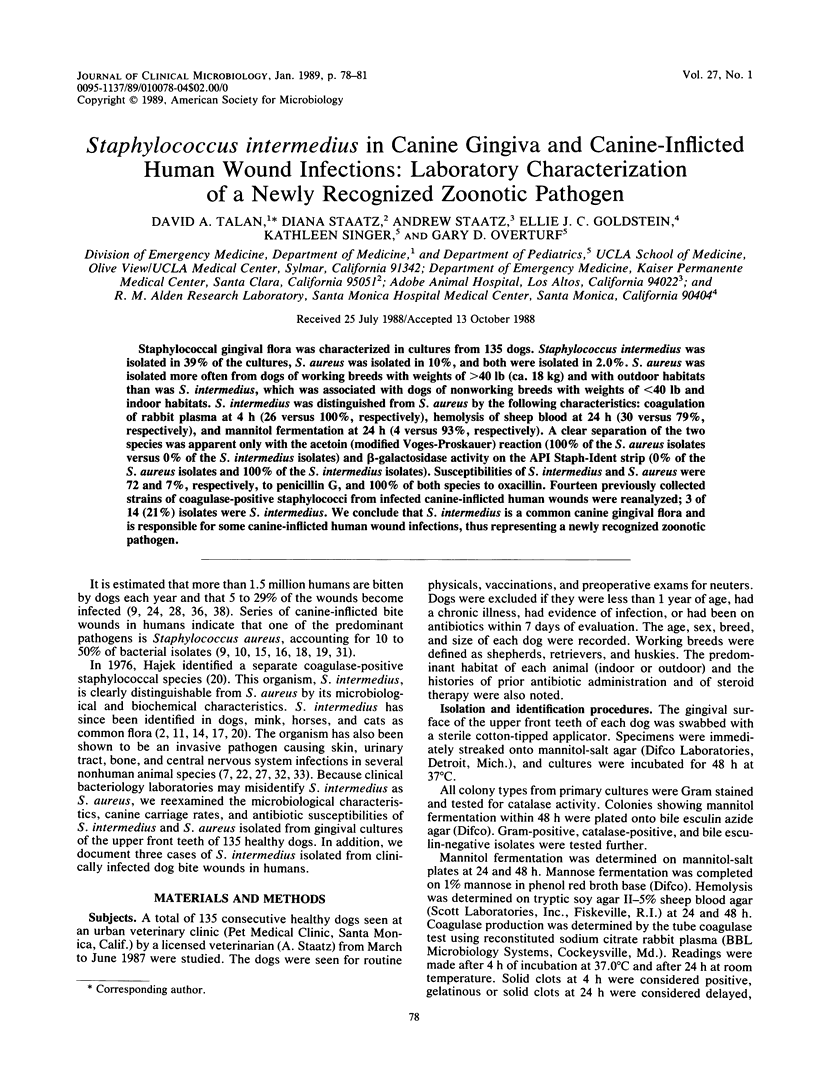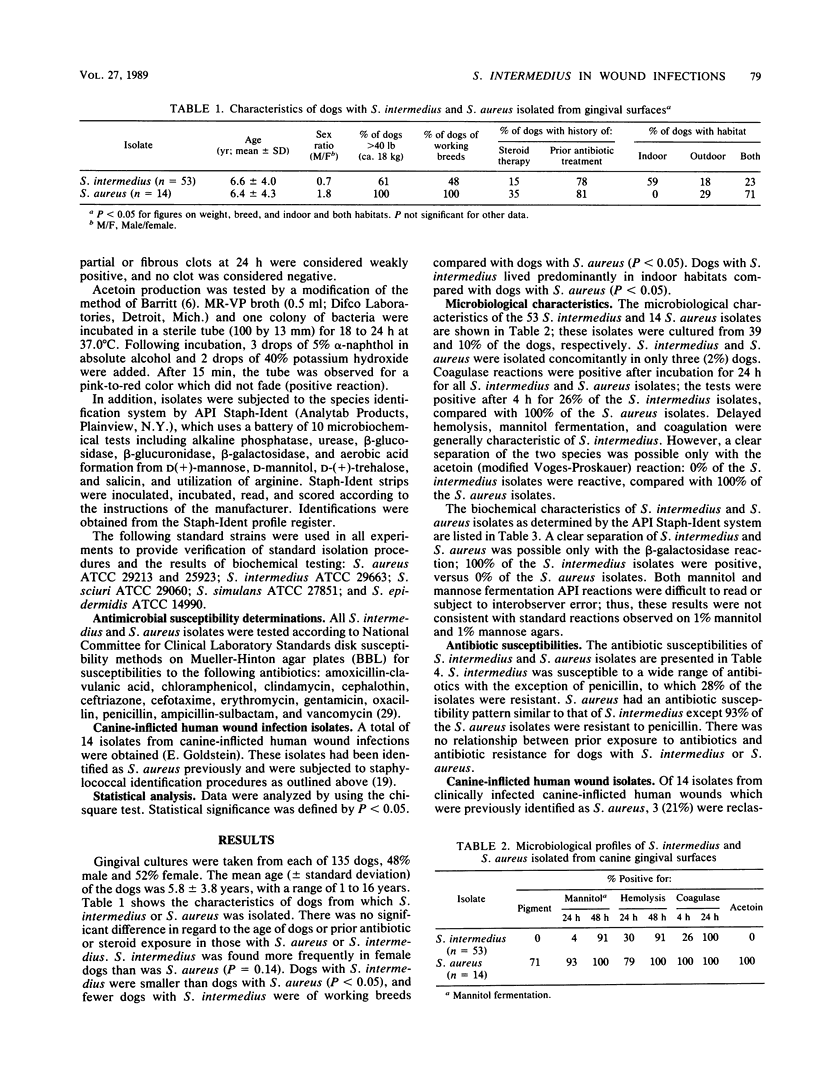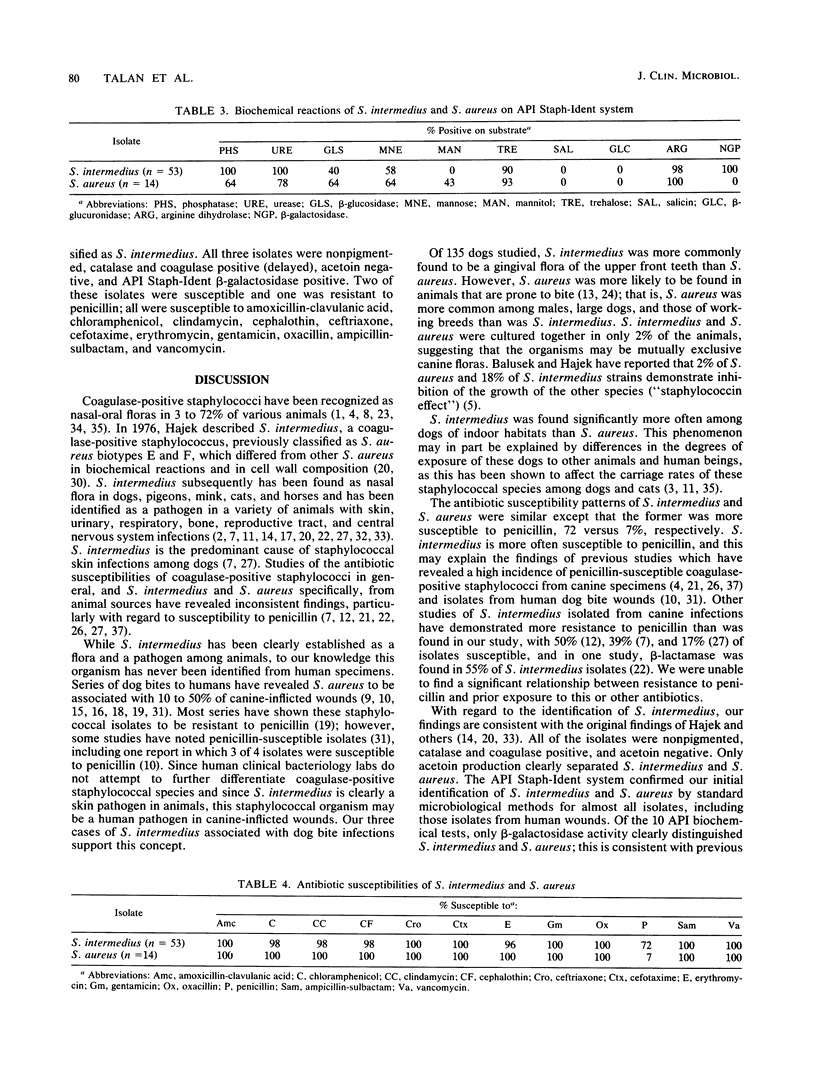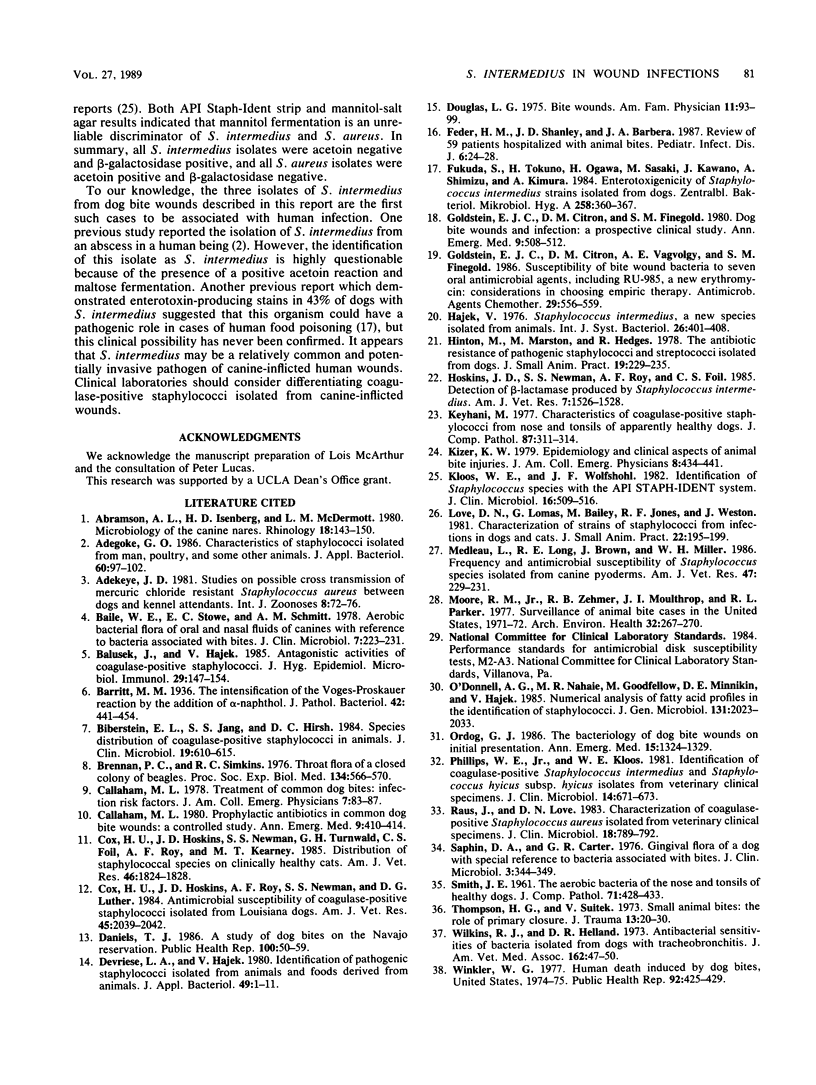Abstract
Staphylococcal gingival flora was characterized in cultures from 135 dogs. Staphylococcus intermedius was isolated in 39% of the cultures, S. aureus was isolated in 10%, and both were isolated in 2.0%. S. aureus was isolated more often from dogs of working breeds with weights of greater than 40 lb (ca. 18 kg) and with outdoor habitats than was S. intermedius, which was associated with dogs of nonworking breeds with weights of less than 40 lb and indoor habitats. S. intermedius was distinguished from S. aureus by the following characteristics: coagulation of rabbit plasma at 4 h (26 versus 100%, respectively), hemolysis of sheep blood at 24 h (30 versus 79%, respectively), and mannitol fermentation at 24 h (4 versus 93%, respectively). A clear separation of the two species was apparent only with the acetoin (modified Voges-Proskauer) reaction (100% of the S. aureus isolates versus 0% of the S. intermedius isolates) and beta-galactosidase activity on the API Staph-Ident strip (0% of the S. aureus isolates and 100% of the S. intermedius isolates). Susceptibilities of S. intermedius and S. aureus were 72 and 7%, respectively, to penicillin G, and 100% of both species to oxacillin. Fourteen previously collected strains of coagulase-positive staphylococci from infected canine-inflicted human wounds were reanalyzed; 3 of 14 (21%) isolates were S. intermedius. We conclude that S. intermedius is a common canine gingival flora and is responsible for some canine-inflicted human wound infections, thus representing a newly recognized zoonotic pathogen.
Full text
PDF



Selected References
These references are in PubMed. This may not be the complete list of references from this article.
- Abramson A. L., Isenberg H. D., McDermott L. M. Microbiology of the canine nasal cavities. Rhinology. 1980 Sep;18(3):143–150. [PubMed] [Google Scholar]
- Adegoke G. O. Characteristics of staphylococci isolated from man, poultry and some other animals. J Appl Bacteriol. 1986 Feb;60(2):97–102. doi: 10.1111/j.1365-2672.1986.tb03365.x. [DOI] [PubMed] [Google Scholar]
- Adekeye J. D. Studies on possible cross transmission of mercuric chloride resistant Staphylococcus aureus between dogs and kennel attendants. Int J Zoonoses. 1981 Jun;8(1):72–76. [PubMed] [Google Scholar]
- Bailie W. E., Stowe E. C., Schmitt A. M. Aerobic bacterial flora of oral and nasal fluids of canines with reference to bacteria associated with bites. J Clin Microbiol. 1978 Feb;7(2):223–231. doi: 10.1128/jcm.7.2.223-231.1978. [DOI] [PMC free article] [PubMed] [Google Scholar]
- Balusek J., Hájek V. Antagonistic activities of coagulase-positive staphylococci. J Hyg Epidemiol Microbiol Immunol. 1985;29(2):147–154. [PubMed] [Google Scholar]
- Biberstein E. L., Jang S. S., Hirsh D. C. Species distribution of coagulase-positive staphylococci in animals. J Clin Microbiol. 1984 May;19(5):610–615. doi: 10.1128/jcm.19.5.610-615.1984. [DOI] [PMC free article] [PubMed] [Google Scholar]
- Brennan P. C., Simkins R. C. Throat flora of a closed colony of beagles. Proc Soc Exp Biol Med. 1970 Jun;134(2):566–569. doi: 10.3181/00379727-134-34836. [DOI] [PubMed] [Google Scholar]
- Callaham M. L. Treatment of common dog bites: infection risk factors. JACEP. 1978 Mar;7(3):83–87. doi: 10.1016/s0361-1124(78)80063-x. [DOI] [PubMed] [Google Scholar]
- Callaham M. Prophylactic antibiotics in common dog bite wounds: a controlled study. Ann Emerg Med. 1980 Aug;9(8):410–414. doi: 10.1016/s0196-0644(80)80153-3. [DOI] [PubMed] [Google Scholar]
- Cox H. U., Hoskins J. D., Newman S. S., Turnwald G. H., Foil C. S., Roy A. F., Kearney M. T. Distribution of staphylococcal species on clinically healthy cats. Am J Vet Res. 1985 Sep;46(9):1824–1828. [PubMed] [Google Scholar]
- Cox H. U., Hoskins J. D., Roy A. F., Newman S. S., Luther D. G. Antimicrobial susceptibility of coagulase-positive staphylococci isolated from Louisiana dogs. Am J Vet Res. 1984 Oct;45(10):2039–2042. [PubMed] [Google Scholar]
- Daniels T. J. A study of dog bites on the Navajo reservation. Public Health Rep. 1986 Jan-Feb;101(1):50–59. [PMC free article] [PubMed] [Google Scholar]
- Devriese L. A., Hájek V. Identification of pathogenic staphylococci isolated from animals and foods derived from animals. J Appl Bacteriol. 1980 Aug;49(1):1–11. doi: 10.1111/j.1365-2672.1980.tb01038.x. [DOI] [PubMed] [Google Scholar]
- Douglas L. G. Bite wounds. Am Fam Physician. 1975 Apr;11(4):93–99. [PubMed] [Google Scholar]
- Feder H. M., Jr, Shanley J. D., Barbera J. A. Review of 59 patients hospitalized with animal bites. Pediatr Infect Dis J. 1987 Jan;6(1):24–28. doi: 10.1097/00006454-198701000-00007. [DOI] [PubMed] [Google Scholar]
- Fukuda S., Tokuno H., Ogawa H., Sasaki M., Kishimoto T., Kawano J., Shimizu A., Kimura S. Enterotoxigenicity of Staphylococcus intermedius strains isolated from dogs. Zentralbl Bakteriol Mikrobiol Hyg A. 1984 Dec;258(2-3):360–367. doi: 10.1016/s0176-6724(84)80054-1. [DOI] [PubMed] [Google Scholar]
- Goldstein E. J., Citron D. M., Finegold S. M. Dog bite wounds and infection: a prospective clinical study. Ann Emerg Med. 1980 Oct;9(10):508–512. doi: 10.1016/s0196-0644(80)80188-0. [DOI] [PubMed] [Google Scholar]
- Goldstein E. J., Citron D. M., Vagvolgyi A. E., Finegold S. M. Susceptibility of bite wound bacteria to seven oral antimicrobial agents, including RU-985, a new erythromycin: considerations in choosing empiric therapy. Antimicrob Agents Chemother. 1986 Apr;29(4):556–559. doi: 10.1128/aac.29.4.556. [DOI] [PMC free article] [PubMed] [Google Scholar]
- Hinton M., Marston M., Hedges R. The antibiotic resistance of pathogenic staphylococci and streptococci isolated from dogs. J Small Anim Pract. 1978 Apr;19(4):229–235. doi: 10.1111/j.1748-5827.1978.tb05478.x. [DOI] [PubMed] [Google Scholar]
- Hoskins J. D., Newman S. S., Roy A. F., Foil C. S., Cox H. U. Detection of beta-lactamase produced by Staphylococcus intermedius. Am J Vet Res. 1985 Jul;46(7):1526–1528. [PubMed] [Google Scholar]
- Keyhani M. Characteristics of coagulase-positive staphylococci from nose and tonsils of apparently healthy dogs. J Comp Pathol. 1977 Apr;87(2):311–314. doi: 10.1016/0021-9975(77)90019-6. [DOI] [PubMed] [Google Scholar]
- Kloos W. E., Wolfshohl J. F. Identification of Staphylococcus species with the API STAPH-IDENT system. J Clin Microbiol. 1982 Sep;16(3):509–516. doi: 10.1128/jcm.16.3.509-516.1982. [DOI] [PMC free article] [PubMed] [Google Scholar]
- Love D. N., Lomas G., Bailey M., Jones R. F., Weston I. Characterization of strains of Staphylococci from infections in dogs and cats. J Small Anim Pract. 1981 Apr;22(4):195–199. doi: 10.1111/j.1748-5827.1981.tb01405.x. [DOI] [PubMed] [Google Scholar]
- Medleau L., Long R. E., Brown J., Miller W. H. Frequency and antimicrobial susceptibility of Staphylococcus species isolated from canine pyodermas. Am J Vet Res. 1986 Feb;47(2):229–231. [PubMed] [Google Scholar]
- Moore R. M., Jr, Zehmer R. B., Moulthrop J. I., Parker R. L. Surveillance of animal-bite cases in the United States, 1971-1972. Arch Environ Health. 1977 Nov-Dec;32(6):267–270. doi: 10.1080/00039896.1977.10667293. [DOI] [PubMed] [Google Scholar]
- O'Donnell A. G., Nahaie M. R., Goodfellow M., Minnikin D. E., Hájek V. Numerical analysis of fatty acid profiles in the identification of staphylococci. J Gen Microbiol. 1985 Aug;131(8):2023–2033. doi: 10.1099/00221287-131-8-2023. [DOI] [PubMed] [Google Scholar]
- Ordog G. J. The bacteriology of dog bite wounds on initial presentation. Ann Emerg Med. 1986 Nov;15(11):1324–1329. doi: 10.1016/s0196-0644(86)80620-5. [DOI] [PubMed] [Google Scholar]
- Phillips W. E., Jr, Kloos W. E. Identification of coagulase-positive Staphylococcus intermedius and Staphylococcus hyicus subsp. hyicus isolates from veterinary clinical specimens. J Clin Microbiol. 1981 Dec;14(6):671–673. doi: 10.1128/jcm.14.6.671-673.1981. [DOI] [PMC free article] [PubMed] [Google Scholar]
- Raus J., Love D. N. Characterization of coagulase-positive Staphylococcus intermedius and Staphylococcus aureus isolated from veterinary clinical specimens. J Clin Microbiol. 1983 Oct;18(4):789–792. doi: 10.1128/jcm.18.4.789-792.1983. [DOI] [PMC free article] [PubMed] [Google Scholar]
- SMITH J. E. The aerobic bacteria of the nose and tonsils of healthy dogs. J Comp Pathol. 1961 Oct;71:428–433. doi: 10.1016/s0368-1742(61)80047-7. [DOI] [PubMed] [Google Scholar]
- Saphir D. A., Carter G. R. Gingival flora of the dog with special reference to bacteria associated with bites. J Clin Microbiol. 1976 Mar;3(3):344–349. doi: 10.1128/jcm.3.3.344-349.1976. [DOI] [PMC free article] [PubMed] [Google Scholar]
- Thomson H. G., Svitek V. Small animal bites: the role of primary closure. J Trauma. 1973 Jan;13(1):20–23. [PubMed] [Google Scholar]
- Wilkins R. J., Helland D. R. Antibacterial sensitivities of bacteria isolated from dogs with tracheobronchitis. J Am Vet Med Assoc. 1973 Jan 1;162(1):47–50. [PubMed] [Google Scholar]
- Winkler W. G. Human deaths induced by dog bites, United States, 1974-75. Public Health Rep. 1977 Sep-Oct;92(5):425–429. [PMC free article] [PubMed] [Google Scholar]


